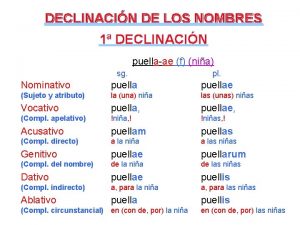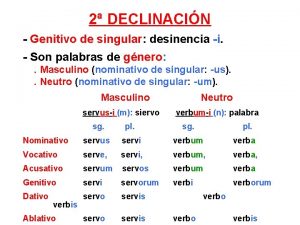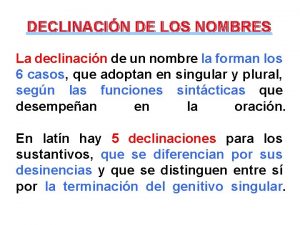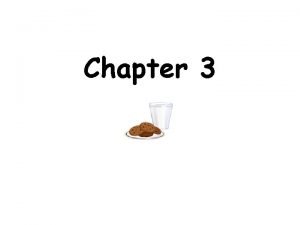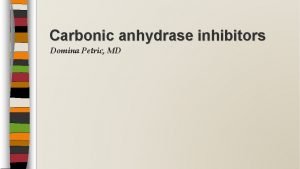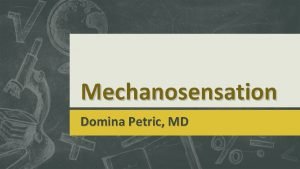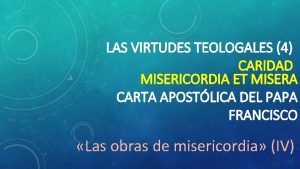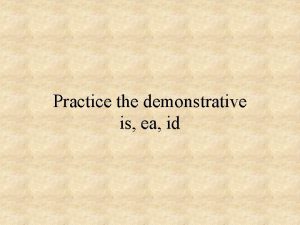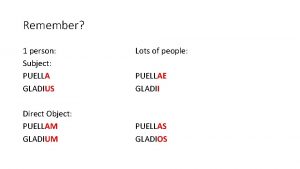caupo iratus lectus sordidus puella misera domina irata





























- Slides: 29




caupo iratus lectus sordidus puella misera domina irata




1. Quid servi cauponis parare possunt? 2. Vultne Aurelia statim cenare? 3. Quid fecit Aurelia ubi lectum vidit? 4. Quid servi in cubiculum portaverunt? 5. Cur Cornelia cenare non vult? 6. Quid fecerunt Aurelia et Cornelia?

The present tense is used to show action in the present. Right now. Hodie Cornelii cenant. Heri Cornelii cenaverunt. The perfect tense is the simple past tense. It is the tense used for simple occurrences in the past.

The present tense is used to show action in the present. Right now. Hodie caupo Aureliam ad cubiculum ducit. Heri caupo Aureliam ad cubiculum duxit. The perfect tense is the simple past tense. It is the tense used for simple occurrences in the past.

The present tense is used to show action in the present. Right now. Hodie Marcus iubet Sextum pilam iacere. Heri Marcus iussit Sextus pilam iacere. The perfect tense is the simple past tense. It is the tense used for simple occurrences in the past.

Diu Flavia picturam pingebat. Flavia nunc picturam pinxit. While the imperfect tenses shows action in the past that was repeated or continued… …the perfect tense shows a single occurrence. It is the simple past tense. Per multas horas femina pingebat. Puer picturam pinxit. Non iam pingebat.

Cornelii in cauponā pernoctabant. Cornelii in cauponā pernoctaverunt. While the imperfect tenses shows action in the past that was repeated or continued… …the perfect tense shows a single occurrence. It is the simple past tense. Vir non legebat sed iam dormiebat. Femina non iam dormiebat sed surrexit.

Marcus et Sextus pilam iaciebant. While the imperfect tenses shows action in the past that was repeated or continued… Pater et filius pilā ludebant. Sextus ad Corneliam pilam iecit. …the perfect tense shows a single occurrence. It is the simple past tense. Pater et filius pilā luderunt et deinde discesserunt.

The simple past tense. Present Imperfect Perfect ambulabat ambulavit apparebat apparuit ducunt ducebant duxerunt iubebant iusserunt The perfect tense is translated as a simple past tense (“-ed”) or with “have” or “did”.

• Represents simple completed action in the past, as opposed to the imperfect, which shows on-going or repeated action. • Translate as a simple past tense: • apparuit, he appeared • iusserunt, they ordered • ambulavit, she walked • Translate with “have”: • he has appeared, they have ordered, she has walked • In questions, or when adding emphasis, use “did”: • he did appear, didn’t they sit? • non ambulavit, she didn’t walk

Let’s recap what they are. • Present Tense: verb action going on right now, today, at this moment. ducit, she is leading, she does lead, she leads • Imperfect Tense: verb action that began in the past, extended over a period of time or perhaps happened repeatedly. The action may still be ongoing. ducebat: she was leading, she used to lead, she began to lead, she kept leading • Perfect Tense: verb action completed in the past. This is the simple past tense. duxit: she led, she has led duxitne: did she lead?

The simple past tense. How does it look different from the imperfect and present tenses? Present Imperfect Perfect ambulabat ambulavit apparent apparebant apparuerunt ducit ducebat duxit iubebat iussit ferunt ferebant tulerunt While the present and imperfect tenses use the same stem to which they add their endings, the perfect tense uses a different stem.

Describe these pictures using the perfect forms provided. Make plurals from the singular verbs by substituting –erunt for –it. audivit portavit iecit ludit aperuit egit (agere) lacrimavit habuit tulit (ferre) cenavit sessit clamavit cucurrit intravit ambulavit expectavit traxit appropinquavit stetit (stare) surrexit festinavit movit apparuit arripuit

Why does the perfect tense look so different? apparet pernoctat apparuit pernoctavit ducunt duxerunt iubent iusserunt

duco, ducere, duxi, ductus 1 st principal part: duco The present tense: I am leading 2 nd principal part: ducere The infinitive: to lead 3 rd principal part: duxi The perfect tense: I led, I have led 4 th principal part: ductus The perfect passive participle: an adjective made from the verb, having been led. We do not use this principle part until Latin 2. You have been using the first two principal parts for a long time.

Uses the 3 rd principal part for its formation: Drop the –i and add the ending Duco, ducere, duxi, ductus: duxi dux- +- it = he led dux- + -erunt = they led intravit, she entered intraverunt, they entered misit, he sent miserunt, they sent egit, she drove egerunt, they drove habuit, he had habuerunt, they had

The Good News: even irregular verbs are regular in the perfect tense! voluit, he wanted voluerunt, they wanted noluit, he didn’t want noluerunt, they didn’t want tulit, she brought tulerunt, they brought iit/ivit, she went ierunt, iverunt, they went fuit, he was fuerunt, they were potui, she could potuerunt, they could

Perfect Tense n n Shows completed action; it is the simple past tense. Translate using ¨ ¨ ¨ n Uses 3 rd principal part: ¨ ¨ n Have/has Did -ed (simple past) Drop the –i Add perfect ending (-it, -erunt) Watch for stem markers for the 3 rd PP: ¨ ¨ ¨ -v-: audivit, portavit -u-: aperuit, apparuit -x-: duxit, surrexit -s-: gerit gessit, iubet Vowel change: agit egit iussit

e. Xtra long - SUV

Double XLong - SUV

Perfect Tense Using your vocab sheet, change these verbs from present to perfect tense. Then translate. 1. Marcus ramum arripit et ad lupum iacit. 2. Sextus Corneliam ferire in animo non habet. 3. Cornelius Syrum incitare equos iubet. 4. Cornelius ad fratrem in urbe epistulam mittit. 5. Cornelii cauponam intrant et ibi cenant. 6. Servi cauponis Syrum et equos ad cauponas ducunt. 7. Sunt duo lecti sordidi in cubiculo Aureliae et Corneliae.

Oral practice How many different sentences can you make out of the fragments below by substituting different perfect verbs? 1. Cornelia epistulam ______. 2. Marcus et Sextus cenam ______. 3. Princeps legatum fortem _______. 4. Homines in lecto _________. Use your orange vocab sheets for principal parts.

 Dinanzi al vero tu misera cadesti
Dinanzi al vero tu misera cadesti Irata training
Irata training Uprorar
Uprorar Declinacion puella
Declinacion puella Declinacion templum
Declinacion templum Declinacion puella
Declinacion puella Puella pronunciation
Puella pronunciation Domina petric
Domina petric Domina los aprendizajes requeridos
Domina los aprendizajes requeridos Carbonic anhydrase use
Carbonic anhydrase use Domina petric
Domina petric Domina petric
Domina petric Türkische domina
Türkische domina Domina petric
Domina petric Domina petric
Domina petric Petric acid
Petric acid Casi indiretti
Casi indiretti As 8 atitudes vencedoras
As 8 atitudes vencedoras Cada miembro domina una parcela determinada del proyecto
Cada miembro domina una parcela determinada del proyecto Domina petric
Domina petric



